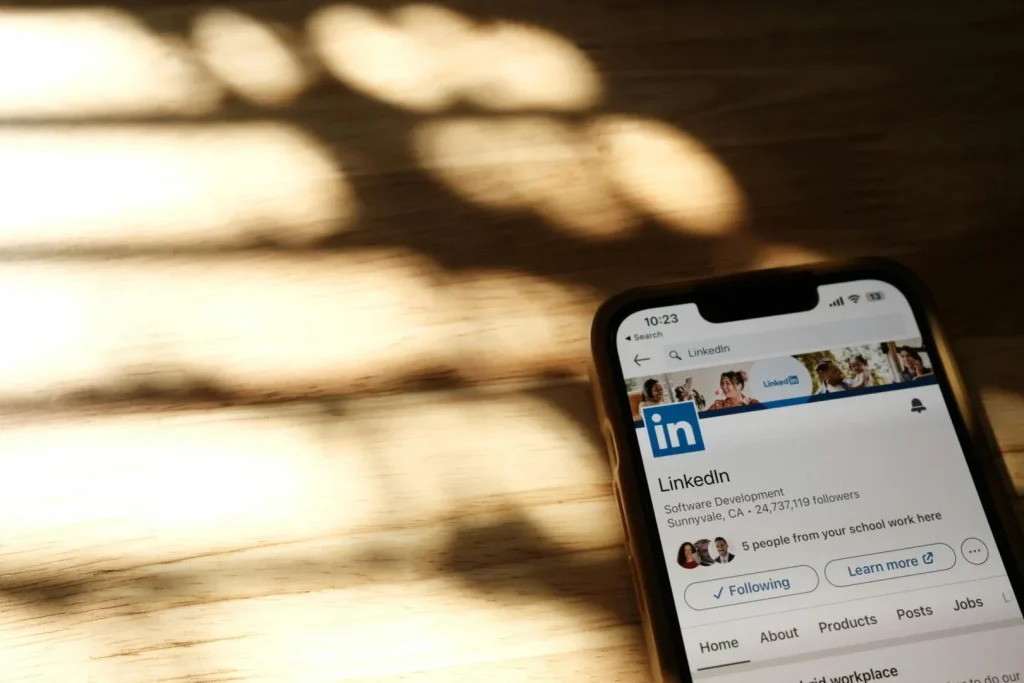Known primarily as a platform for career growth and professional networking, LinkedIn is proving to be a goldmine for B2C brands, especially those in the ecommerce space.
LinkedIn’s user base consists predominantly of professionals, decision-makers, and industry influencers, making it an ideal platform for B2B (Business to Business) as well as B2C (Business to Consumer) brands that aim to target a professional audience. The environment is conducive to thoughtful, business-related content, setting the stage for brands to engage with their audience in a more meaningful and impactful way.
The shift towards LinkedIn for advertising by prestigious brands such as Van Cleef & Arpels isn’t just a fleeting trend but a strategic move to capitalize on the unique opportunities this platform offers.
Unlike other social networks, LinkedIn is home to a vast array of professionals who not only have a higher-than-average disposable income but are also in a mindset conducive to engaging with content that can add value to their professional and personal lives. This makes LinkedIn an ideal platform for ecommerce brands looking to target a more affluent and engaged audience.
Whether you’re a new player in the market or an established brand looking to diversify your advertising strategy, understanding how to leverage LinkedIn can be a game-changer for your ecommerce business.

LinkedIn, launched in 2003, has grown from a small networking site for professionals to a colossal platform that boasts over 700 million members worldwide.
In the ever-evolving world of digital marketing, ecommerce brands are continually searching for the next untapped advertising platform to reach potential high-value customers. While many turn to the usual suspects like Facebook, Instagram, or Google Ads, a surprising yet profoundly effective contender is emerging from the professional networking world: LinkedIn.
Targeting High-Value Professionals
One of LinkedIn’s most compelling features for ecommerce advertisers is its user base. The platform is teeming with professionals from various industries, many of whom hold positions that come with significant purchasing power.
This demographic is not just scrolling through their feeds aimlessly; they are on LinkedIn to engage with content that resonates with their professional and personal growth goals. For ecommerce brands, this presents a unique opportunity to present products and services to an audience that is not only capable of affording them but is also in the right mindset to consider such investments.
The potential for a lower cost of acquisition comes into play when you consider the precision with which you can target your ads on LinkedIn. Instead of casting a wide net and hoping to catch a few high-value customers, LinkedIn allows you to specifically target individuals based on their job titles, industries, and even the size of the companies they work for. This level of granularity ensures that your advertising budget is spent on reaching those most likely to convert, making LinkedIn an efficient platform for targeting high-value professionals.
Moreover, LinkedIn’s professional environment naturally filters out a significant portion of the low-intent traffic that plagues other social platforms. Users are less likely to engage with content that doesn’t pertain to their professional interests or aspirations, meaning that the clicks and interactions your ads receive are from genuinely interested parties. This not only improves the quality of your leads but can also enhance the overall ROI of your advertising campaigns.
Precise Targeting Options
One of the standout features that set LinkedIn apart from other advertising platforms is its sophisticated targeting capabilities. LinkedIn allows advertisers to drill down into the specifics of their desired audience with a level of precision that’s unmatched, particularly in the professional sphere.
This granularity in targeting is crucial for ecommerce brands looking to connect with a specific segment of professionals or decision-makers within certain industries.
The targeting options on LinkedIn include job titles, which allow you to reach individuals holding specific roles within an organization. This is particularly useful for products or services that are tailored to the needs or interests of people in certain positions. Additionally, targeting by industry and company size can help ensure that your ads are seen by professionals who are most likely to be interested in what you’re offering, based on the relevance to their field or the scale of their business operations.
The importance of these targeting options has grown in the wake of changes to other platforms’ advertising algorithms and privacy regulations, which have made accurate targeting more challenging. LinkedIn’s ability to maintain precise targeting capabilities makes it an increasingly attractive platform for ecommerce brands seeking to reach a highly relevant audience efficiently.
Furthermore, LinkedIn also offers targeting based on interests and skills, which can be incredibly effective for ecommerce brands. By targeting users who have demonstrated an interest or expertise in areas related to your products, you can increase the relevance of your ads and, consequently, the likelihood of engagement and conversion.
Professional Brand Building
Advertising on LinkedIn offers an additional, often overlooked benefit: the opportunity to build and reinforce your brand’s professional image. In the context of LinkedIn, ads are not just a means to drive immediate sales; they are also a way to establish your ecommerce brand as a credible and authoritative player in your industry.
This aspect of LinkedIn advertising is especially beneficial for newer ecommerce brands or those looking to make inroads into B2B markets. By presenting your brand in a professional setting, surrounded by content and interactions that are inherently business-oriented, you can enhance the perception of your brand’s reliability and trustworthiness.
Moreover, the content and tone of your LinkedIn ads should reflect the professional environment of the platform. This doesn’t mean that creativity or brand personality should be sacrificed, but rather that they should be tailored to resonate with a professional audience.
Highlighting the utility, quality, and innovation of your products can appeal to the professional ethos of LinkedIn users, making your brand stand out as both relevant and desirable.

Step-by-Step Guide to Creating Effective LinkedIn Ads
Creating effective LinkedIn ads requires a strategic approach that combines a clear understanding of your objectives with a creative execution that resonates with a professional audience. Here’s a comprehensive guide to setting up a LinkedIn advertising campaign that can drive both brand awareness and sales for your ecommerce brand:
Define Your Campaign Objectives: Start by determining what you want to achieve with your LinkedIn ads. Whether it’s driving traffic to your website, generating leads, or directly promoting product sales, your objectives will guide all other aspects of your campaign.
Select the Right Ad Format: LinkedIn offers various ad formats, including Sponsored Content, Sponsored InMail, and Text Ads, each with its unique advantages. Choose the format that best aligns with your campaign goals and the preferences of your target audience.
Craft Compelling Ad Content: Your ad copy and visuals need to strike a balance between professionalism and brand personality. Use high-quality images, concise and persuasive text, and a clear call-to-action (CTA) to engage your audience.
Utilize LinkedIn’s Targeting Options: Leverage LinkedIn’s detailed targeting options to define your audience with precision. Use the insights from your market research to select the job titles, industries, company sizes, and interests that align with your ideal customer profile.
Set Your Budget and Schedule: Determine your budget based on the scope of your campaign and the competition for your target audience. LinkedIn offers options for cost per click (CPC) and cost per impression (CPM) bidding, allowing you to optimize your spend based on your campaign objectives.
Launch and Monitor Your Campaign: Once your ads are live, closely monitor their performance. Pay attention to metrics like click-through rate (CTR), conversion rate, and return on ad spend (ROAS) to gauge the effectiveness of your ads.
Optimize for Performance: Use the insights gathered from your campaign performance to make data-driven adjustments. Test different ad creatives, targeting options, and bidding strategies to continually improve your results.
Case Studies: Ecommerce Brands Winning on LinkedIn
To illustrate the potential of LinkedIn advertising for ecommerce, let’s look at a couple of success stories:
Brand A, a luxury watch retailer, used LinkedIn’s precise targeting to reach professionals in the finance industry, a key demographic for their high-end products. By crafting ads that emphasized the craftsmanship and prestige of their watches, Brand A saw a significant increase in website traffic and sales from LinkedIn users.
Brand B, an online platform for professional development courses, utilized Sponsored InMail to directly engage with HR professionals. The personalized approach, combined with a compelling offer, resulted in a high conversion rate for course sign-ups.
These case studies demonstrate the versatility of LinkedIn ads and the potential for ecommerce brands to achieve tangible results when strategies are well-executed.
Tracking and Measuring Success
To ensure the effectiveness of your LinkedIn advertising efforts, it’s crucial to track and measure key performance indicators (KPIs). LinkedIn provides robust analytics tools that allow you to monitor the performance of your ads in real-time. Key metrics to focus on include:
Click-Through Rate (CTR): This measures the effectiveness of your ad in compelling users to click. A higher CTR indicates more engaging content.
Conversion Rate: This metric shows the percentage of users who took the desired action (such as making a purchase or signing up for a newsletter) after clicking on your ad.
Return on Ad Spend (ROAS): ROAS calculates the revenue generated for every dollar spent on advertising. It’s a crucial metric for assessing the profitability of your campaigns.

Overcoming Challenges and Maximizing ROI
Even with a well-planned LinkedIn advertising strategy, ecommerce brands might face challenges that can impede their campaign success. Understanding these common pitfalls and learning how to navigate them is crucial for maximizing your advertising ROI.
Common Pitfalls in LinkedIn Advertising and How to Avoid Them
1. Overgeneralized Targeting: While LinkedIn’s targeting options are precise, there’s a risk of either overgeneralizing your audience or making it too narrow. Overgeneralized targeting can lead to wasted ad spend on uninterested users, while overly narrow targeting can limit your ad’s reach.
Solution: Find a balance in targeting that aligns with your buyer personas but is not so narrow that it excludes potential customers. Regularly review and adjust your targeting criteria based on campaign performance data.
2. Ignoring Ad Content Quality: In a professional environment like LinkedIn, the quality of your ad content can significantly impact your brand’s perception. Poorly designed visuals or unengaging copy can deter potential customers.
Solution: Invest in high-quality visuals and craft compelling ad copy that resonates with the professional nature of LinkedIn users. A/B testing different versions of your ads can also help identify what content works best.
3. Underestimating the Importance of LinkedIn’s Ad Formats: LinkedIn offers various ad formats, each suited for different campaign goals. Not utilizing the right format can hinder your campaign’s effectiveness.
Solution: Understand the strengths of each ad format and choose the one that best matches your campaign objectives. For instance, Sponsored Content is ideal for broad reach, while Sponsored InMail offers a more personalized approach.
Advanced Strategies for Boosting LinkedIn Ad Performance
To further enhance your LinkedIn advertising efforts, consider these advanced strategies:
1. Leverage LinkedIn’s Lead Gen Forms: LinkedIn’s Lead Gen Forms can significantly increase your conversion rates by making it easy for users to share their contact information without leaving the platform. These forms pre-populate with the user’s LinkedIn profile data, streamlining the process.
2. Utilize Content Marketing Synergy: Combine your LinkedIn advertising with a robust content marketing strategy. Share valuable, informative content that positions your brand as a thought leader in your industry. This not only increases engagement with your ads but also builds long-term trust with your audience.
3. Explore Account-Based Marketing (ABM): LinkedIn is an ideal platform for implementing ABM strategies, where you target specific high-value accounts rather than individual leads. Use LinkedIn’s targeting options to reach decision-makers within your identified key accounts, delivering personalized ad content that speaks directly to their needs and pain points.
Conclusion
Implementing the strategies outlined in this blog, from creating compelling ads to leveraging advanced features like Lead Gen Forms and ABM, can significantly enhance the effectiveness of your LinkedIn advertising campaigns. Remember, success on LinkedIn requires a blend of strategic targeting, high-quality content, and continuous optimization based on performance data.
As ecommerce continues to evolve, so too should your advertising strategies. LinkedIn represents not just a platform for professional networking but a dynamic advertising channel that can drive both brand awareness and sales for ecommerce businesses.
If you have any questions or need further assistance in leveraging LinkedIn for your ecommerce brand, feel free to reach out in the comments section below or visit our website.
Soodo
http://soodo.coSoodo | Shopify Website Development